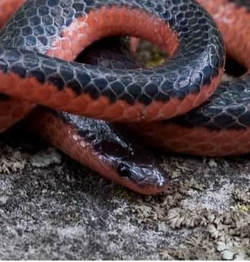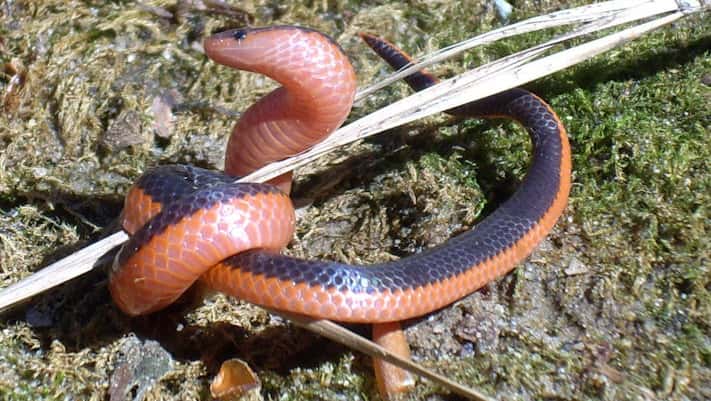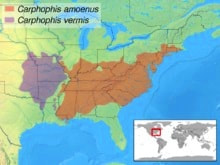Worm Snakegenus Carphophis |

Custom Search
|
|
The worm snake (genus Carphophis) is small colubrid non-venomous snake endemic to the central and eastern United States.
There are 2 recognized species in the Carphophis genus, known as the worm snake (Carphophis amoenus) with 2 subspecies and the western worm snake (Carphophis vermis). Some of the species preferred habitats include of moist, rocky, wooded or partially wooded areas most often in hilly areas but they are sometimes found in flat-woods. These little snakes are also found in forest or woodland edges near wetlands, cypress swamps or farm fields. Worm snakes usually hide under leaf litter, mulch piles, weedy pastures, under rocks, dead logs, tree barks, or rotting stumps, and also in loose damp soil. During cold or dry weather these small fossorial snakes go deeper underground. These are little snakes reaching only about 13 or 14 inches (33 to 35 cm) in total length. Females are usually bigger than the males. Worm snakes usually have a light to dark brown upper-side, while their underside is of a lighter coloration, ranging from pink or orange to white. This light color found on the belly, sometimes extends and is visible on the sides of the body.
Their body is covered with smooth shiny scales, they also have a narrow pointed head with small, round, black eyes, and a sharp tail tip. Juvenile specimens are similar in appearance to adult snakes.
Worm snakes are fairly easily mistaken for other similar snake species, like the brown snake Storeria dekayi), rough earth snake (Haldea striatula), red-bellied snake (Storeria occipitomaculata) or the ring-necked snake (Diadophis punctatus). The worm snake is a fossorial species, meaning it spends most of its life buried in the loose, rocky soil, or under the forest leaf litter. That is why although considered abundant in their natural habitat, they are rarely seen in the wild. Although harmless to humans, since they aren't venomous, if picked up they will often press their pointed tail tip against their captor. These little snakes are commonly preyed upon by other Ophiophagus snakes species like the highly venomous coral snakes in habitats in which they are found together. But they also fall prey to many other predators such as birds, large lizards, toads, and even some small mammals like skunks, Oppossums or foxes. They can live up to 4 years in the wild. The worm snake is becoming popular among snake lovers and is sometimes kept as a pet, with their shy nature they are very suitable for beginners. Species
Eastern worm snake (Carphophis amoenus amoenus - Say, 1825) - Found in the eastern United States, ranging from southern New England to central Georgia and west to the Mississippi River. Western worm snake (Carphophis vermis - Kennicott, 1859) - Found West of the Mississippi River, in southeastern Nebraska, Missouri, southern Iowa, eastern Kansas, western Illinois, Louisiana, eastern Oklahoma, and northeastern Texas. There were some isolated specimens found on southeastern regions of Arkansas and Wisconsin. Diet / Feeding These little snakes feed almost entirely on earthworms and grubs, which the worm snake finds by burrowing deep into the soil. But sometimes they may eat soft-bodied or insects, and on very rare occasions they may even feed on small salamanders, slugs or snails. Reproduction Not much is known about the worm snake mating habits, but they most likely mate in the fall and early spring. Before being laid the eggs can be seen through the female's translucent underside. The eggs are laid in early summer in June to mid-July, usually under rocks or inside rotting logs or stumps. The clutch size is related to the female size and age, ranging from 2 to 12 small eggs. The eggs are slightly elongated in shape and about 1 inch long. After an incubation period of almost 2 months, in which the mother stays near the eggs, they hatch in August or September. At birth, the worm snake hatchlings range in length from 3 to 5 inches (7 to 12 cm). Conservation / Threats Both species of the worm snake are considered common and with no major threats known to significantly threaten these snakes. In some locations, their population has probably declined as a result of habitat conversion to intensive human uses. The species is considered as threatened in Massachusetts, protected throughout the state of Georgia and a species of special concern in Rhode Island.
|
Did You Know?
Found in South America the mighty green anaconda is considered the largest snake in the world. Scientific classification |
© 2014 Snake Facts About Us | Privacy Policy | Contact





